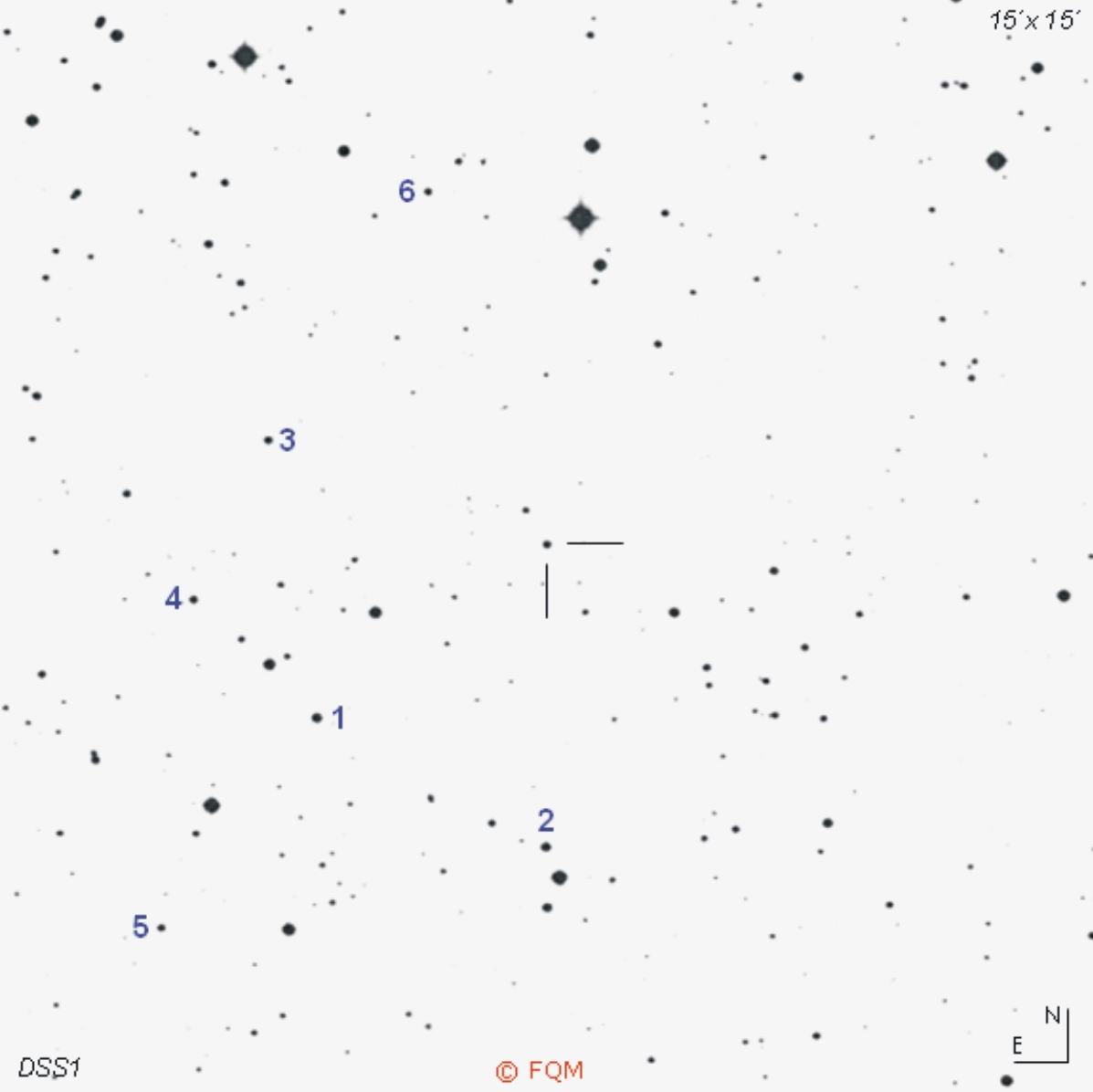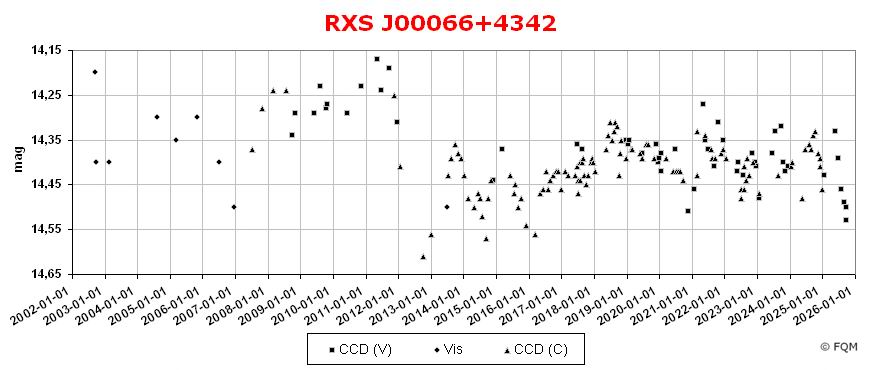
| Frankfurt Quasar Monitoring |
| RXS J00066+4342 |
| Cross-Identifications | 1RXS J000637.1+434223, IRAS F00040+4325 2MASS J00063656+4342283, LQAC 001+043 001 [VCV2006] J000636.6+434229 WISEA J000636.56+434228.2 |
| Equat. coordinates | RA 00 06 36.6 DE +43 42 29 (J2000) |
| Constellation | Andromeda |
| Type | QSO |
| Redshift |
z=0.166 |
| Distance (2) (3) | 654 Mpc |
| Total mag range (mv) (4) (5) | 14.1 - 14.7 |
| Catalog Magnitude (1) | 14.80 B |
| Absolute Magnitude (1) | -25.2 MB |
| Light Travel-Time (2) | 1.977 × 109 yrs |

| star | B | V |
| 1 | 14.204 (0.034) | 13.555 (0.030) |
| 2 | 14.742 (0.050) | 13.830 (0.049) |
| 3 | 14.897 (0.063) | 14.319 (0.029) |
| 4 | 15.309 (0.034) | 14.499 (0.042) |
| 5 | 15.386 (0.079) | 14.735 (0.010) |
| 6 | 15.513 (0.052) | 14.803 (0.053) |

| RXS
J00066+4342 is a bright quasar in Andromeda, about 7° NW of the famous
Andromeda Galaxy.
In the
early 1980s, RXS J00066+4342
was first recognized as an infrared source by the IRAS
survey. In 1990, it was identified as an X-ray source by ROSAT
(RXS). Later on, it was classified as a quasar by spectral analysis
during the Asiago-ESO/RASS
Quasar
Survey. During latter survey, a redshift of
z=0.166 was determined, which corresponds to a light travel-time of
about 2×109
years ! RXS J00066+4342 was first listed as a quasar in the 2001 edition of the quasar catalogue by Véron-Cetty & Véron. RXS J00066+4342 is a low amplitude variable object with a total range of only about 0.5 mag. No data on significant optical variability have been published to date. Observations by the Frankfurt Quasar Monitoring programme have confirmed an optical variability ranging only within a few tenth of a magnitude. 14-mag RXS J00066+4342 appears as a stellar object in telescopes of 8- to 10-inch of aperture and larger. CCD observers, as well as visual observers, shall use the comparison stars given above. ____________
Some deep sky showpieces around quasar RXS J00066+4342 are worth
visiting. First, of course, there is the Andromeda galaxy (M31), some
7° SE. Besides its two close companions M32 and NGC 205, another two
fainter satellite galaxies shall not be missed: NGC 147 and NGC 185,
both some 7° NE of the quasar. By turning 7.5° to the west we meet another famous deep sky showpiece: NGC 7662, the "Blue Snowball", a very bright planetary nebula with an exceptionally bluish colour. Stargazers who like to observe some more bright and optically variable sources of quasi-stellar photons may turn to three BL Lac objects, all of them some 20° away from quasar RXS J00066+4342: - 3C 66A (24.7° E) - S2 0109+22 (24° SE) - BL Lac (22.4° W) |
| Barkhouse, W.A., Hall, P.B. 2001, AJ, 122, 496; Quasars in the 2MASS Second Incremental Data Release. Grazian, A., Cristiani, S., et al. 2000, AJ, 119, 2540; The Asiago-ESO/RASS QSO Survey. I. The Catalog and the Local QSO Luminosity Function. Karge, S.; Helle Quasare für 8- bis 10-Zoll Teleskope. Ein Beobachtungsführer zur visuellen Beobachtung von Quasaren und BL Lacertae Objekten; Frankfurt 2005. Moshir, M., Kopan, G., et al. 1990; IRAS Faint Source Catalogue, Version 2.0. Véron-Cetty, M.-P., Véron, P. 2001, A&A 374, 92; A Catalogue of Quasars and Active Nuclei: 10th edition. Véron-Cetty, M.-P., Véron, P. 2003, A&A 412, 399; A Catalogue of Quasars and Active Nuclei: 11th edition. Véron-Cetty, M.-P., Véron, P. 2006, A&A 455, 776; A Catalogue of Quasars and Active Nuclei: 12th edition. Véron-Cetty, M.-P., Véron, P. 2010, A&A 518, 10; A Catalogue of Quasars and Active Nuclei: 13th edition. Voges, W., Aschenbach, B., et al. 1999, A&A, 349, 389; The ROSAT All-Sky Survey Bright Source Catalogue. |
| Link: APASS |
| home |